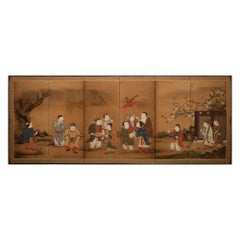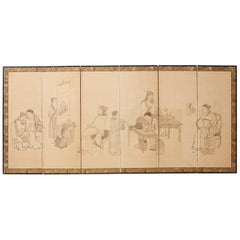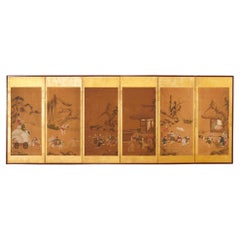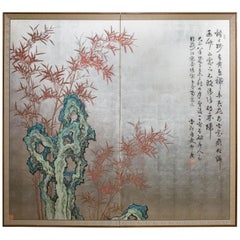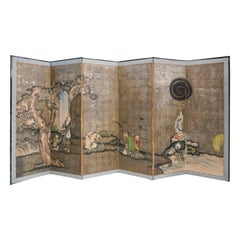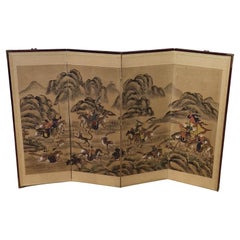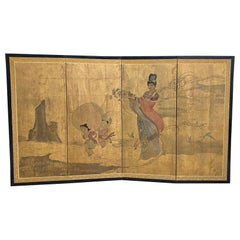Chinese Japanese Screens
Antique 18th Century Japanese Paintings and Screens
Bronze
Antique 19th Century Japanese Edo Paintings and Screens
Silk, Wood, Paper
Antique 19th Century Japanese Edo Paintings and Screens
Gold Leaf
Early 20th Century Japanese Taisho Paintings and Screens
Silk, Paper, Wood
Antique 19th Century Japanese Meiji Paintings and Screens
Brass
Antique 19th Century Japanese Edo Paintings and Screens
Gold Leaf
Antique 18th Century Japanese Edo Paintings and Screens
Gold Leaf
20th Century Chinese Meiji Paintings and Screens
Bronze
20th Century Chinese Paintings and Screens
Gold Leaf
Antique 19th Century Japanese Edo Paintings and Screens
Silver Leaf, Brass
Antique 17th Century Japanese Edo Paintings and Screens
Brass
Antique 19th Century Paintings and Screens
Brocade, Silk
Antique 17th Century Edo Paintings and Screens
Gold Leaf
20th Century Asian Showa Paintings and Screens
Wood, Paper
20th Century Paintings and Screens
Gold Leaf
Antique Early 19th Century Japanese Paintings and Screens
Gold Leaf
20th Century Chinese Showa Paintings and Screens
Brass
Early 20th Century Japanese Showa Paintings and Screens
Silk, Wood, Paint
Antique Mid-19th Century Asian Meiji Paintings and Screens
Silk
Antique 19th Century Chinese Edo Paintings and Screens
Bronze
Antique 19th Century Chinese Meiji Paintings and Screens
Bronze
Antique 19th Century Chinese Meiji Paintings and Screens
Bronze
Antique 19th Century Chinese Meiji Paintings and Screens
Bronze
Antique 19th Century Chinese Meiji Paintings and Screens
Bronze
Antique 19th Century Chinese Meiji Paintings and Screens
Bronze
Antique 19th Century Chinese Meiji Paintings and Screens
Bronze
Early 20th Century Japanese Meiji Paintings and Screens
Bamboo
20th Century Mid-Century Modern Screens and Room Dividers
Wrought Iron
Vintage 1930s Chinese Chinoiserie Wall-mounted Sculptures
Wood
20th Century Japanese Chinese Export Tribal Art
Silk
Late 20th Century English Chinese Export Books
Paper
Antique Mid-19th Century Napoleon III Paintings
Canvas
Mid-20th Century Symbolist Figurative Prints
Lithograph
Vintage 1940s American Books
Paper
21st Century and Contemporary American Impressionist Landscape Prints
Lithograph
Antique 19th Century Japanese Paintings and Screens
Ink
Antique Mid-19th Century Japanese Edo Paintings and Screens
Paper
21st Century and Contemporary Chinese Paintings and Screens
Wood, Paper
21st Century and Contemporary Chinese Paintings and Screens
Gold Leaf
21st Century and Contemporary Chinese Paintings and Screens
Silver Leaf
21st Century and Contemporary Chinese Paintings and Screens
Silver Leaf
21st Century and Contemporary Chinese Paintings and Screens
Gold Leaf
2010s Chinese Paintings and Screens
Gold Leaf
21st Century and Contemporary Chinese Paintings and Screens
Gold Leaf
2010s Chinese Paintings and Screens
Gold Leaf
Antique 1760s Japanese Edo Paintings and Screens
Paper
21st Century and Contemporary Abstract Expressionist Abstract Paintings
Canvas, Resin, Ink, Acrylic
21st Century and Contemporary Abstract Expressionist Abstract Paintings
Canvas, Resin, Ink, Acrylic
21st Century and Contemporary Abstract Expressionist Abstract Paintings
Canvas, Resin, Ink, Acrylic
21st Century and Contemporary Contemporary Abstract Paintings
Canvas, Resin, Ink, Acrylic
21st Century and Contemporary Contemporary Abstract Paintings
Canvas, Resin, Ink, Acrylic
21st Century and Contemporary Contemporary Abstract Paintings
Canvas, Resin, Ink, Acrylic
21st Century and Contemporary Abstract Expressionist Abstract Paintings
Canvas, Resin, Ink, Acrylic
21st Century and Contemporary Abstract Expressionist Abstract Paintings
Canvas, Resin, Ink, Acrylic
21st Century and Contemporary Abstract Expressionist Abstract Paintings
Canvas, Resin, Ink, Acrylic
21st Century and Contemporary American Contemporary Art
Silver Leaf
Antique Early 19th Century Japanese Edo Paintings and Screens
Fabric, Paint, Paper, Wood
Antique 19th Century Japanese Edo Paintings and Screens
Gold Leaf, Brass
Antique 19th Century Japanese Edo Paintings and Screens
Brass, Silver Leaf
Mid-20th Century Japanese Paintings and Screens
Paper
- 1
Chinese Japanese Screens For Sale on 1stDibs
How Much are Chinese Japanese Screens?
- What is a Chinese screen?1 Answer
 Lotus GallerySeptember 23, 2020
Lotus GallerySeptember 23, 2020A Chinese screen can refer to a number or things, including standing folding room dividers, architectural window or door screen panels, or even decorative latticework hangings.
- 1stDibs ExpertAugust 17, 2021Japanese screens are called Byōbu and are made from many panels with beautiful calligraphy and paintings. These folding screens can be a decorative and interesting way to separate rooms in a living space. Find a collection of Japanese screens for sale on 1stDibs.
- 1stDibs ExpertApril 5, 2022Japanese screen painting is the art of creating byōbu, or Japanese screens. Byōbu vary in subject matter and style. The screens are free-standing, portable and decorated with symbolic images or calligraphy. It is common to find byōbu in pairs with at least two panels. Shop a selection of byōbu on 1stDibs.
- 1stDibs ExpertApril 5, 2022A Chinese Coromandel screen is a folding piece of furniture produced in China by artisans working with a certain material. Specifically, the screens are Coromandel, a hardwood that features black and brown stripes. The screens often function as room dividers, but some people display them purely for decorative purposes. On 1stDibs, find a collection of Coromandel screens.
- Is jade Japanese or Chinese?1 Answer
 Lotus GallerySeptember 23, 2020
Lotus GallerySeptember 23, 2020While both the Chinese and Japanese use jade, it is more commonly used in China.
- Is Buddha Chinese or Japanese?2 Answers1stDibs ExpertFebruary 22, 2021The Buddha's origins are Chinese, but Buddhism has since made its way to Japan and, later, Korea.
 Lotus GalleryMarch 17, 2021Gautama Buddha was an Indian prince born in modern day Nepal. The first images of the Buddha were created almost simultaneously in Mathura, India, and the Greco-Buddhist kingdom of Gandhara (modern day Pakistan and Afghanistan). From there, images fo the Buddha spread out along trade routes into East and Southeast Asia.
Lotus GalleryMarch 17, 2021Gautama Buddha was an Indian prince born in modern day Nepal. The first images of the Buddha were created almost simultaneously in Mathura, India, and the Greco-Buddhist kingdom of Gandhara (modern day Pakistan and Afghanistan). From there, images fo the Buddha spread out along trade routes into East and Southeast Asia.  Lotus GalleryMarch 17, 2021A Japanese low screen was traditionally used while seated upon the floor. The low screen would block wind and drafts, provide limited privacy, and are often decorated with seasonal themes.
Lotus GalleryMarch 17, 2021A Japanese low screen was traditionally used while seated upon the floor. The low screen would block wind and drafts, provide limited privacy, and are often decorated with seasonal themes.- 1stDibs ExpertOctober 15, 2024To tell if art is Japanese or Chinese, study the piece's characteristics. With paintings, Chinese artists often use more color and tend to fill their entire canvases, while Japanese artists often include more negative space and choose subtler colors. There are also differences between the brushstrokes typical of traditional Chinese and Japanese art. In Japanese paintings, brushstrokes are often short and sharp. On the other hand, Chinese paintings often display longer, more fluid brushstrokes. Learning about the defining features of various art forms and periods and looking at examples of pieces made by Japanese and Chinese artists can help you learn to spot subtle differences. Explore a diverse assortment of Japanese and Chinese art on 1stDibs.
- 1stDibs ExpertMarch 25, 2024Jimmy Choo is neither Chinese nor Japanese. The designer is actually Malaysian. He was born Zhou Yang Jie in Penang, Malaysia, in 1948. He was inspired by watching the work of his father, who was a shoe designer, and at the age of 11, he made his first pair of shoes for his mom's birthday. On 1stDibs, find a collection of Jimmy Choo shoes and accessories.
- 1stDibs ExpertMarch 22, 2022To tell the difference between Chinese cloisonné and Japanese cloisonné, look closely at the surface. Generally, Japanese cloisonné looks glassy because of the grinding and buffing process used to produce it. Chinese cloisonné appears less glossy and may even have an almost matte finish. Shop a variety of cloisonné jewelry and decorative objects on 1stDibs.
